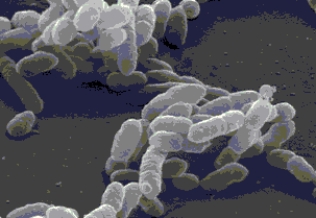A) cellular proteins.
B) cellular organization.
C) the presence of a cell wall.
D) nutritional requirements.
E) the number of cells in the organism.
G) B) and E)
Correct Answer

verified
Correct Answer
verified
Multiple Choice
Antibiotics are produced by
A) bacteria.
B) viruses.
C) fungi.
D) protozoa.
E) bacteria and fungi.
G) C) and D)
Correct Answer

verified
Correct Answer
verified
Multiple Choice
Figure 1.1
 -The bacterial shape of the cells in Figure 1.1 would best be described as
-The bacterial shape of the cells in Figure 1.1 would best be described as
A) coccus.
B) bacillus.
C) ovoid.
D) columnar.
E) spiral.
G) A) and E)
Correct Answer

verified
Correct Answer
verified
Multiple Choice
The term used to describe a disease- causing microorganism is
A) microbe.
B) infection.
C) virus.
D) bacterium.
E) pathogen.
G) A) and C)
Correct Answer

verified
Correct Answer
verified
Multiple Choice
Biogenesis refers to the
A) spontaneous generation of organisms from nonliving matter.
B) development of life forms from preexisting life forms.
C) germ theory of disease.
D) development of aseptic technique.
F) A) and C)
Correct Answer

verified
Correct Answer
verified
True/False
Spontaneous generation refers to living cells arising only from other living cells.
B) False
Correct Answer

verified
Correct Answer
verified
Multiple Choice
The formal system for classifying and naming organisms was developed by
A) Carolus Linnaeus.
B) Robert Koch.
C) Aristotle.
D) Louis Pasteur.
E) Ignaz Semmelweis.
G) C) and D)
Correct Answer

verified
Correct Answer
verified
Multiple Choice
The use of phenol (carbolic acid) as a wound disinfectant was first practiced by
A) Lister.
B) Semmelweis.
C) Koch.
D) Holmes.
E) Pasteur.
G) C) and D)
Correct Answer

verified
Correct Answer
verified
True/False
Infectious disease is almost totally eradicated in our world.
B) False
Correct Answer

verified
Correct Answer
verified
Multiple Choice
Each of the following organisms would be considered a microbe EXCEPT
A) virus.
B) bacterium.
C) mushroom.
D) yeast.
E) protozoan.
G) A) and C)
Correct Answer

verified
Correct Answer
verified
Multiple Choice
Which of the following is NOT a domain in the three- domain system?
A) bacteria
B) archaea
C) eukarya
D) animalia
F) C) and D)
Correct Answer

verified
Correct Answer
verified
Multiple Choice
The first step for directly linking a microbe to a specific disease according to Koch's postulates is to
A) inject a sample of blood or other body fluid from a diseased animal into a healthy animal.
B) isolate microbes from the blood of healthy animals.
C) culture the blood or other body fluid from a diseased animal using nutrient medium.
D) obtain a sample of blood or other body fluid from a diseased animal.
E) compare the blood of a sick animal to blood obtained from a healthy animal.
G) A) and B)
Correct Answer

verified
Correct Answer
verified
Multiple Choice
Development of emerging infectious disease can be a result of all of the following EXCEPT
A) changes in the environment.
B) overuse of antibiotics.
C) microbial mutation.
D) modern transportation.
E) use of genetically modified foods.
G) B) and E)
Correct Answer

verified
Correct Answer
verified
True/False
A student has obtained a sample of pond water for study. Using the high- power lens, he observes several cells with nuclei. He can conclude that the cells are NOT bacteria.
B) False
Correct Answer

verified
Correct Answer
verified
Multiple Choice
Recombinant DNA technology has become an increasingly important part of our life. It is used for all of the following EXCEPT
A) drug production.
B) enhancing food longevity.
C) synthesis of water.
D) vaccine production.
E) increasing the nutritional value of food.
G) C) and E)
Correct Answer

verified
Correct Answer
verified
Multiple Choice
Viruses are not considered living organisms because they
A) are structurally very simple.
B) typically associated with disease.
C) cannot reproduce by themselves.
D) can only be visualized using an electron microscope.
E) are ubiquitous in nature.
G) C) and D)
Correct Answer

verified
Correct Answer
verified
Showing 41 - 56 of 56
Related Exams